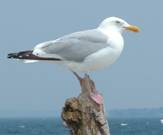|
"Your gateway to
understanding |
Gulls

- New York status: Common
- Three species occur around Oneida Lake
- Intense scavengers that will eat almost anything
Gulls are larger and bulkier than terns, and have tails that are square rather than forked. Their plumage is usually white with gray or black markings on the back, wings, and head. Gulls have long, narrow wings that are adapted to soaring and they have webbed feet adapted to swimming. They tend to have strong bills that are hooked at the end. Gulls eat clams, fish, and sometimes insects, but are most successful as scavengers in harbors and bays. They are often seen hovering over boats looking for food, and seeking refuse in parking lots and landfills.
The most common gull on Oneida Lake is the herring gull (Larus argentatus). These gulls are large animals with a wingspan of almost 150cm (5 feet). On Oneida Lake, herring gulls have increased from 22 pairs in 1979 to 71 pairs in 2006. In addition to the standard gull diet, herring gulls are known to consume the eggs and chicks of terns and other water birds. These birds are aggressive and will eat almost anything they can grasp.
The great black-backed gull (Larus marinus) has a more northern range than that of the herring gull. Great black-backed gulls are the largest gulls in the world, and have a wingspan that approaches 168cm (5.5 feet). Coupled with its size, this gull’s aggressive behavior allows it to prey on almost anything it can catch. Like the herring gull, the great black-backed gull population on Oneida Lake has been increasing, and has gone from one breeding pair in 1993 to 4 pairs in 2006.
The ring-billed gull (Larus delawarensis) is smaller than both other gull species in the area, and is less aggressive. This gull is found more in fields and landfills, and tends to feed on insects, worms, small mammals, and refuse. In the 1980’s and early 1990’s, the Oneida Lake population numbered in the thousands, but declined to about 100 pairs where it stayed until recently. In 2006, the number of ring-billed breeding pairs rose to 220.
To learn more about the Gulls ...
